大家好,我是LinuxZn。
本次分享sys/queue.h:
什么是sys/queue.h?
queue.h是Linux、FreeBSD中的一个头文件。
FreeBSD:FreeBSD 是一种类 UNIX操作系统。
这是一个很实用的头文件,因为这个头文件里全是宏定义操作,所以其不仅可以使用在Linux/嵌入式Linux项目中,也可以使用在单片机项目中,我也是因为在我们的单片机项目中看到,才知道有这么一个头文件的。我觉得挺实用的,与大家分享。
它使用宏实现了如下数据结构:
SLIST:单向无尾链表
LIST:双向无尾链表
STAILQ:单向有尾链表(可作队列使用)
TAILQ:双向有尾链表(可作队列使用)
所有的数据结构都支持如下功能:
在链表头插入节点
在任意节点后插入节点
删除节点
遍历节点
我们可以在Linux系统的如下路径中找到这个头文件:
/usr/include/sys/queue.h
也可以通过如下网址查看:
https://code.woboq.org/userspace/glibc/misc/sys/queue.h.html
sys/queue.h的使用
下面我们基于SLIST来演示其使用。
SLIST相关宏定义:

/* ?*?Singly-linked?List?definitions. ?*/ #define?SLIST_HEAD(name,?type)????????? struct?name?{??????????????????? ?struct?type?*slh_first;?/*?first?element?*/???????? } #define?SLIST_HEAD_INITIALIZER(head)??????? ?{?NULL?} #define?SLIST_ENTRY(type)?????????? struct?{?????????????? ?struct?type?*sle_next;?/*?next?element?*/????? } /* ?*?Singly-linked?List?functions. ?*/ #define?SLIST_INIT(head)?do?{????????? ?(head)->slh_first?=?NULL;????????? }?while?(/*CONSTCOND*/0) #define?SLIST_INSERT_AFTER(slistelm,?elm,?field)?do?{??? ?(elm)->field.sle_next?=?(slistelm)->field.sle_next;??? ?(slistelm)->field.sle_next?=?(elm);??????? }?while?(/*CONSTCOND*/0) #define?SLIST_INSERT_HEAD(head,?elm,?field)?do?{???? ?(elm)->field.sle_next?=?(head)->slh_first;????? ?(head)->slh_first?=?(elm);????????? }?while?(/*CONSTCOND*/0) #define?SLIST_REMOVE_HEAD(head,?field)?do?{?????? ?(head)->slh_first?=?(head)->slh_first->field.sle_next;?? }?while?(/*CONSTCOND*/0) #define?SLIST_REMOVE(head,?elm,?type,?field)?do?{???? ?if?((head)->slh_first?==?(elm))?{??????? ??SLIST_REMOVE_HEAD((head),?field);?????? ?}??????????????? ?else?{?????????????? ??struct?type?*curelm?=?(head)->slh_first;???? ??while(curelm->field.sle_next?!=?(elm))????? ???curelm?=?curelm->field.sle_next;????? ??curelm->field.sle_next?=???????? ??????curelm->field.sle_next->field.sle_next;???? ?}??????????????? }?while?(/*CONSTCOND*/0) #define?SLIST_FOREACH(var,?head,?field)??????? ?for((var)?=?(head)->slh_first;?(var);?(var)?=?(var)->field.sle_next) /* ?*?Singly-linked?List?access?methods. ?*/ #define?SLIST_EMPTY(head)?((head)->slh_first?==?NULL) #define?SLIST_FIRST(head)?((head)->slh_first) #define?SLIST_NEXT(elm,?field)?((elm)->field.sle_next)
?
下面我们通过实例来操作。
首先,创建链表头节点、其它节点结构体,用到SLIST_HEAD与SLIST_ENTRY这两个宏定义:
?
#define?ELEM_TYPE?int
/*?链表节点?*/
typedef?struct?node?
{
????ELEM_TYPE?data;
????SLIST_ENTRY(node)?field;?
}node_st;
/*?链表头?*/
typedef?SLIST_HEAD(head,?node)?head_st;
?
链表数据域类型我们定义为int,field表示的是指针域。
① 创建一个头结点:
?
/*?创建链表头节点并初始化?*/ head_st?*head?=?(head_st?*)malloc(sizeof(head_st)); SLIST_INIT(head);
?
头节点:不存任何数据的空节点,通常作为链表的第一个节点。
② 在链表头部分别插入节点node1、node2:
?
/*?头插法插入一个节点node1?*/ node_st?*node1?=?(node_st?*)malloc(sizeof(node_st)); node1->data?=?1; SLIST_INSERT_HEAD(head,?node1,?field); /*?头插法插入一个节点node2?*/ node_st?*node2?=?(node_st?*)malloc(sizeof(node_st)); node2->data?=?2; SLIST_INSERT_HEAD(head,?node2,?field);

?
头指针:永远指向链表第一个节点的位置。
SLIST_INSERT_HEAD是从链表头部插入节点,新节点总是从头结点之后插入。
③ 在链表节点node2之后插入节点node3:
?
node_st?*node3?=?(node_st?*)malloc(sizeof(node_st)); node3->data?=?3; SLIST_INSERT_AFTER(node2,?node3,?field);
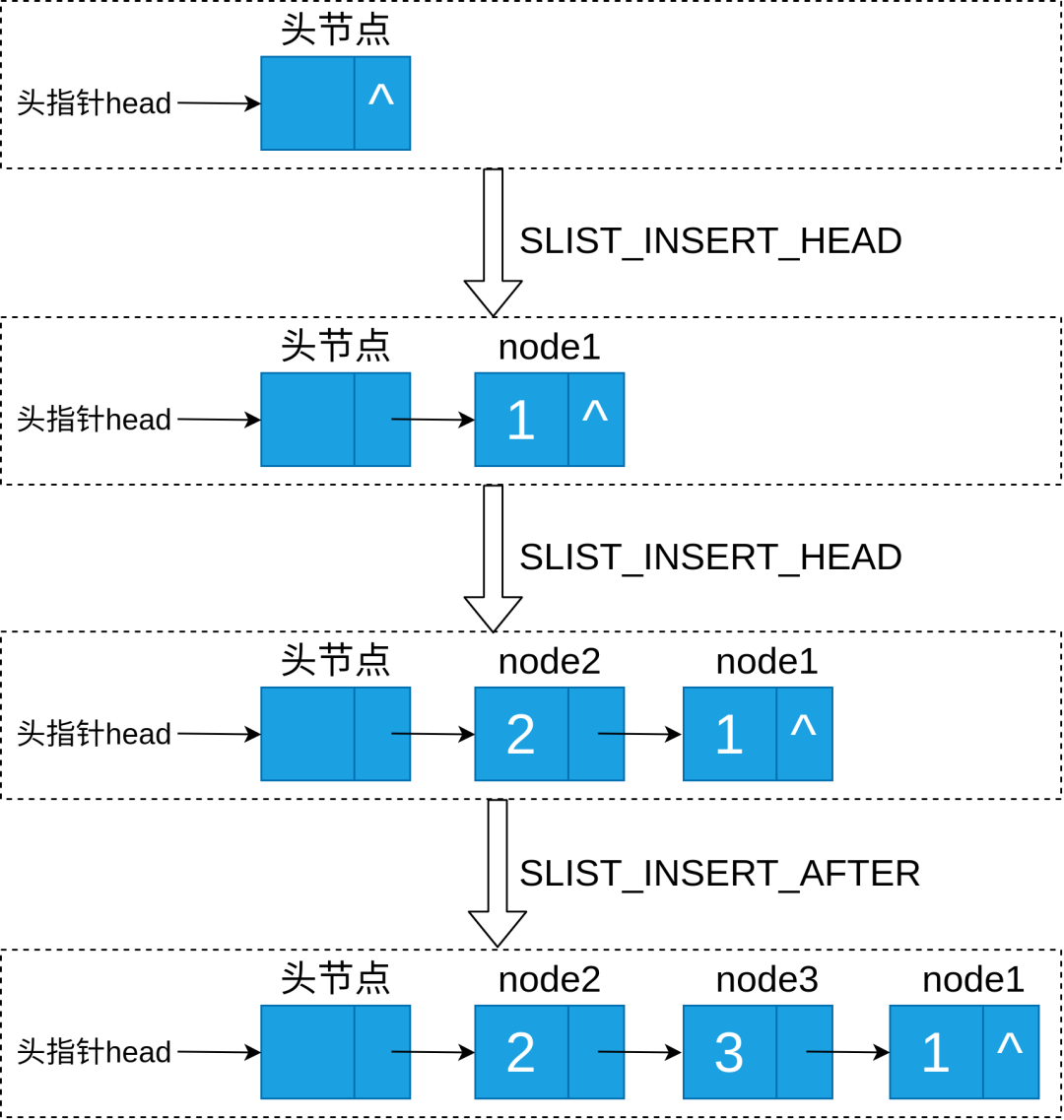
?
SLIST_INSERT_AFTER是从指定节点slistelm之后插入新节点elm。
④ 遍历链表:
?
node_st?*tmp_elm;
SLIST_FOREACH(tmp_elm,?head,?field)
{
?printf("%d?",?tmp_elm->data);
}
?
输出为tmp_elm,访问tmp_elm即可。
⑤ 删除某个节点node2
?
SLIST_REMOVE(head,?node2,?node,?field); free(node2); node2?=?NULL;
?
⑥ 销毁整个链表
?
while?(!SLIST_EMPTY(head))?
{????
????node_st?*p?=?SLIST_FIRST(head);
????SLIST_REMOVE_HEAD(head,?field);
????free(p);
????p?=?NULL;
}
free(head);
head?=?NULL;
?
完整测试代码:
?
#include?#include? #include? #define?ELEM_TYPE?int /*?链表节点?*/ typedef?struct?node? { ????ELEM_TYPE?data; ????SLIST_ENTRY(node)?field;? }node_st; /*?链表头?*/ typedef?SLIST_HEAD(head,?node)?head_st; int?main(void) { ????/*?创建链表头节点并初始化?*/ ????head_st?*head?=?(head_st?*)malloc(sizeof(head_st)); ????SLIST_INIT(head); ????/*?头插法插入一个节点node1?*/ ????node_st?*node1?=?(node_st?*)malloc(sizeof(node_st)); ????node1->data?=?1; ????SLIST_INSERT_HEAD(head,?node1,?field); ????/*?头插法插入一个节点node2?*/ ????node_st?*node2?=?(node_st?*)malloc(sizeof(node_st)); ????node2->data?=?2; ????SLIST_INSERT_HEAD(head,?node2,?field); ????/*?遍历打印当前链表节点?*/ ????printf("list: "); ????node_st?*tmp_elm; ????SLIST_FOREACH(tmp_elm,?head,?field) ????{ ????????printf("%d?",?tmp_elm->data); ????} ????printf(" "); ????/*?尾插法插入一个节点node3?*/ ????printf("insert?node3: "); ????node_st?*node3?=?(node_st?*)malloc(sizeof(node_st)); ????node3->data?=?3; ????SLIST_INSERT_AFTER(node2,?node3,?field); ????SLIST_FOREACH(tmp_elm,?head,?field) ????{ ????????printf("%d?",?tmp_elm->data); ????} ????printf(" "); ????/*?删除node2?*/ ????printf("delete?node2: "); ????SLIST_REMOVE(head,?node2,?node,?field); ????free(node2); ????node2?=?NULL; ????SLIST_FOREACH(tmp_elm,?head,?field) ????{ ????????printf("%d?",?tmp_elm->data); ????} ????printf(" "); ????/*?销毁链表?*/ ????while?(!SLIST_EMPTY(head))? ????{???? ????????node_st?*p?=?SLIST_FIRST(head); ????????SLIST_REMOVE_HEAD(head,?field); ????????free(p); ????????p?=?NULL; ????} ????free(head); ????head?=?NULL; ????return?0; }
?
编译、运行:
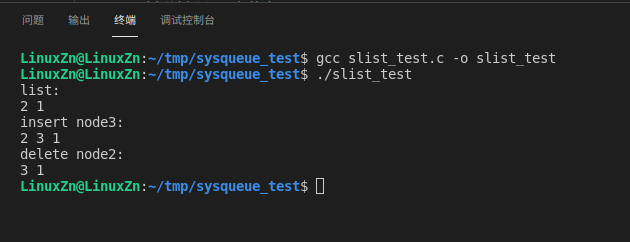
运行结果与我们上面分析的一致。
本次我们只分享queue.h里最简单的数据结构。其它几种数据结构的使用例子及相关宏说明可以通过man命令查看。
man是Linux下的帮助命令。
我们输入 man queue 即可查到queue.h的相关说明:
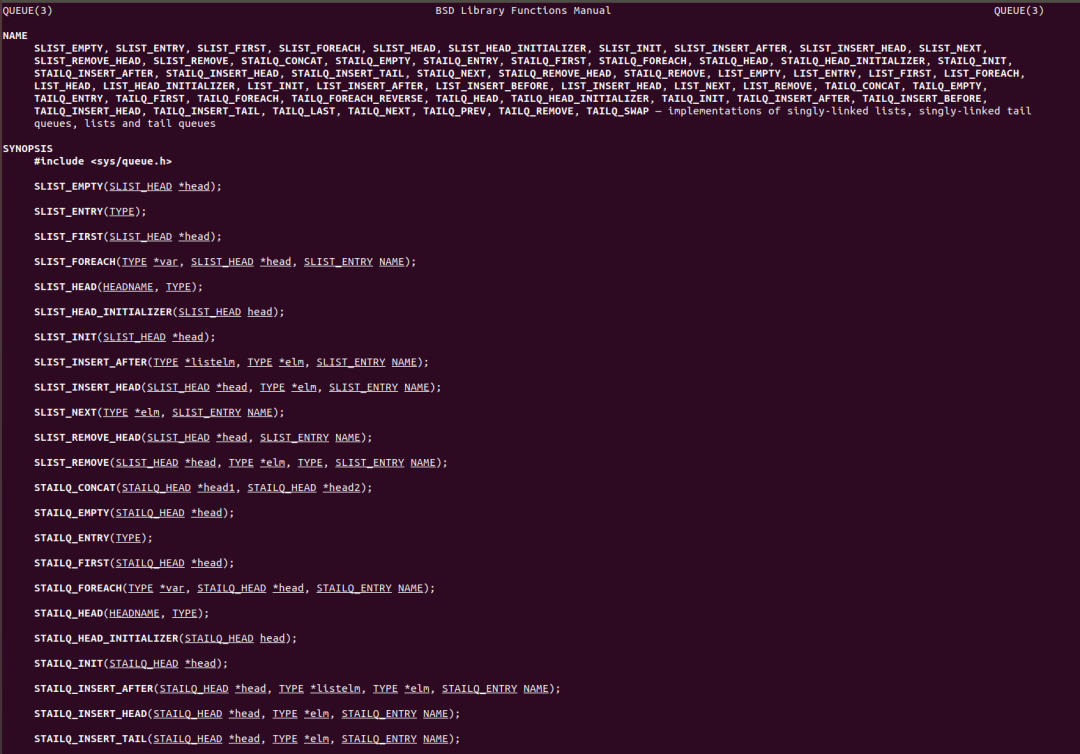
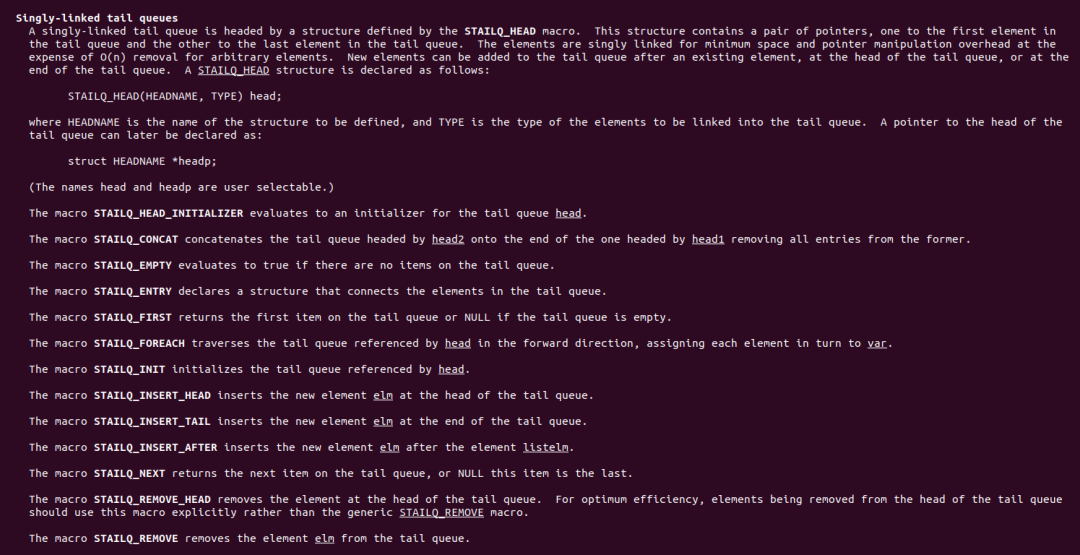
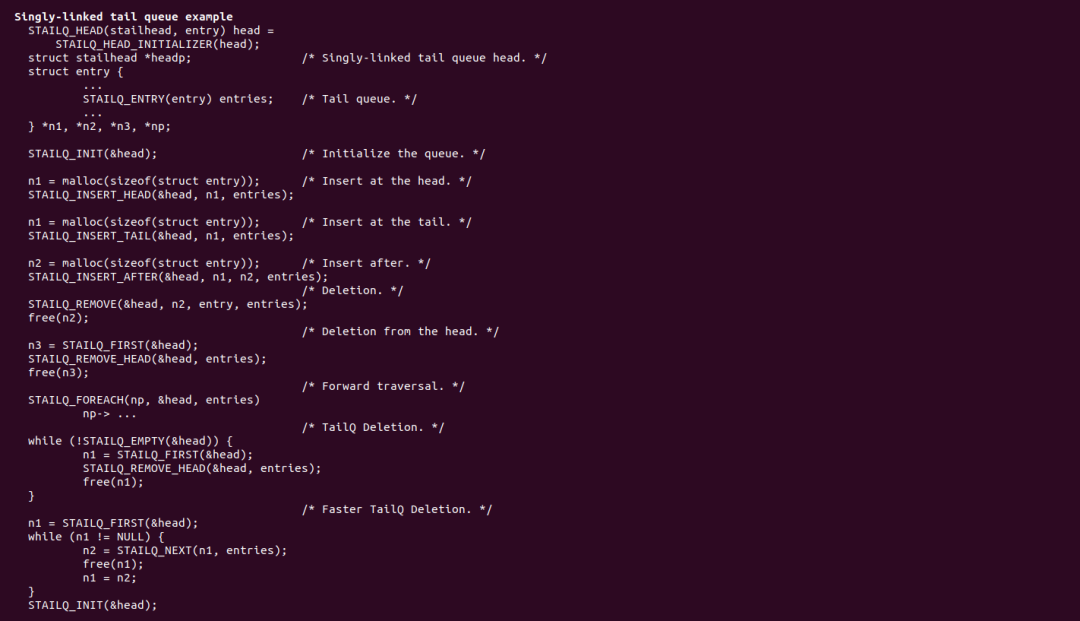
可以看到,man命令很强大,可查到queue的帮助说明很详细,有宏的说明及使用示例等。
以上就是本次的分享,文章如有错误,欢迎支持,谢谢!我们下期见~
审核编辑:汤梓红
 电子发烧友App
电子发烧友App









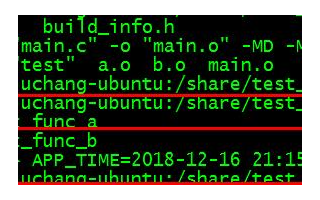


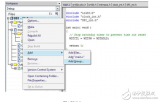
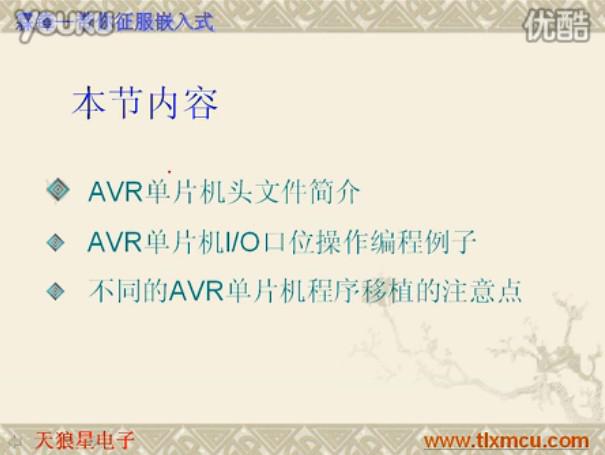

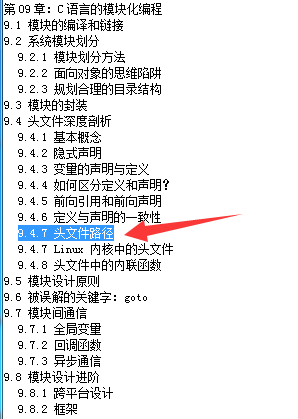


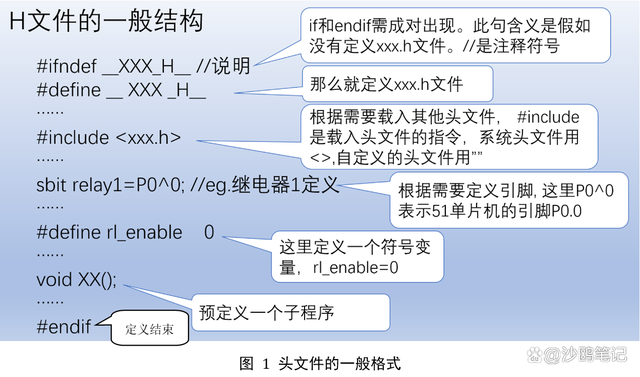
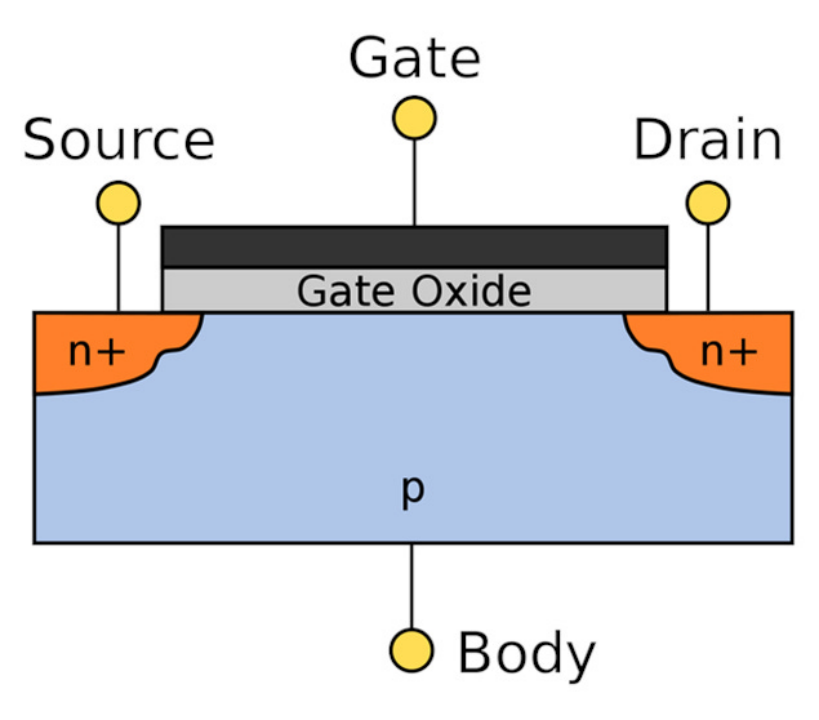










评论